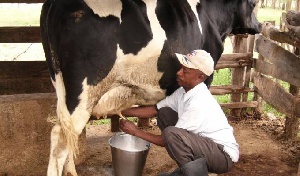Even though the global market for dairy products is growing steadily and is expected to generate revenues worth over US$400billion in 2019, Ghana continuous to lag behind, thereby losing out on this global goldmine.
The Food and Agriculture Organization (FAO) reports that in the last three decades, world milk production has increased by more than 50 percent, from 500 million tonnes in 1983 to 769 million tonnes in 2013.
The same source indicates that the USA is the largest cow milk producer in the world, accounting for 14.4% of world production, producing 91 million tonnes in 2013.
India is the second largest cow milk producer, accounting for 9.5 percent of the world production and producing nearly 61 million tonnes in 2013. The UK is the 10th largest producer, producing nearly 14 million tonnes in 2013 and accounting for 2.2 percent of world cow's milk production.
Of the top ten largest milk producing countries, Turkey and Brazil have shown the largest percentage growth from 2012 to 2013 at 4.2 percent and 6 percent respectively.
Despite having more than 10 percent of the world’s cattle population, Africa contributes less than 3 percent to global milk production but spends more than $500 million every year on milk imports from Europe and North America.
On a continent where there is abundance of cattle, it remains a shocking reality that Africa currently does not produce enough milk to meet its own needs.
Available information shows that milk consumption in Africa is currently the lowest in the world.
According to the World Health Organisation (WHO), the average African consumes about 36kg of milk every year. This is very much below the WHO’s recommended annual consumption of 200kg of milk per person.
The above information makes it very apparent that there is a lot of market for the dairy industry, especially considering the fact that Africa even has a population of more than 1.2 billion.
The case of Ghana
The situation is no different in Ghana. Estimates by the UN Trade Statistics indicate that, as far back as 2011, Ghana spent more than $80 million importing milk and milk products annually.
Ironically, in 1967, Ghana’s first President, Dr. Kwame Nkrumah, established a dairy farm in Amrahia, on the Accra-Dodowa road, as part of his vision to make Ghana an industrialised state.
The farm, as part of its core mandates, was to supply cross bred bulls to prospective dairy farmers for breeding purposes aimed at upgrading the milk production potential of the local breeds of cattle, and to improve milk yield potential of Ghanaian cattle through cross breeding and selection.
Like many other state institutions, however, the Amrahia farms could not live up to its intended purpose after the ousting of Dr. Nkrumah.
The local dairy industry has subsequently been plagued with major challenges that are hampering its growth.
Notable among them is the lack of modern technology that can increase yield. Most dairy farmers continue to use traditional means to extract the milk from the cattle.
Another challenge is a well-organized industry that will assure smallholder farmers a ready market. Most dairy farmers do not even know where to market their products after production.
Almost all the smallholder dairy farmers lack the requisite knowledge to produce to meet standards that will enhance the quality of their products.
Academia to the rescue
To help reverse the trend, the Department of Food and Nutrition Science of the University of Ghana has established two laboraties—the Sensory Evaluation and Microbiological Research laboratories—which were funded by the Council for Technical and Vocational Education and Training (COTVET).
The establishment of the laboratories seeks to enhance teaching, learning and research, and to provide further opportunity for industry practitioners to improve on the quality of their products.
This creates an opportunity for dairy producers to make use of the facility to test the efficacy of their products and eventually help in exportation of dairy products.
Business News of Friday, 7 October 2016
Source: B&FT
Economy losing out on US$400 billion dairy market
Entertainment
















